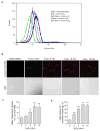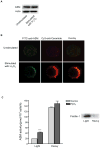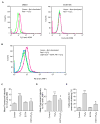Oxidative stress triggers Ca-dependent lysosome trafficking and activation of acid sphingomyelinase
- PMID: 22890197
- PMCID: PMC3777434
- DOI: 10.1159/000341460
Oxidative stress triggers Ca-dependent lysosome trafficking and activation of acid sphingomyelinase
Abstract
Recent studies demonstrate that rapid translocation of the acid sphingomyelinase (ASM), a lysosomal hydrolase, to the outer leaflet of the cell membrane and concomitant release of ceramide constitute a common cellular signaling cascade to various stimuli including CD95 ligation, UV-irradiation, bacterial and viral infections. Reactive oxygen species (ROS) were shown to play a crucial role in regulating this signaling cascade at least for some bacterial infections and UV-irradiation. However, the precise role of ROS for regulation of ASM is unknown. Here, by confocal microscopy and flow cytometry analysis, we demonstrate that hydrogen peroxide (H(2)O(2)), a primary form of ROS in mammalian cells, induces very rapid translocation of ASM and formation of ceramide-enriched membrane platforms in the plasma membrane of Jurkat T cells. In parallel, H(2)O(2) triggers lysosome trafficking and fusion with the plasma membrane, i.e. lysosome exocytosis, as detected by exposure of a lysosome-associated protein, LAMP1. Depletion of intracellular Ca(2+) by cell permeable EGTA-AM inhibits H(2)O(2)-induced lysosome exocytosis, ASM translocation and formation of ceramide-enriched platforms. Pharmacological inhibition or genetic deficiency of ASM did not affect H(2)O(2)-induced lysosome exocytosis. These results indicate that ROS-induced membrane translocation of ASM is mediated by exocytosis of lysosomes, which is dependent on intracellular Ca(2+) release.
Copyright © 2012 S. Karger AG, Basel.
Figures





Similar articles
-
Solving the secretory acid sphingomyelinase puzzle: Insights from lysosome-mediated parasite invasion and plasma membrane repair.Cell Microbiol. 2019 Nov;21(11):e13065. doi: 10.1111/cmi.13065. Epub 2019 Jun 10. Cell Microbiol. 2019. PMID: 31155842 Free PMC article. Review.
-
Neisseria meningitidis Type IV Pili Trigger Ca2+-Dependent Lysosomal Trafficking of the Acid Sphingomyelinase To Enhance Surface Ceramide Levels.Infect Immun. 2019 Jul 23;87(8):e00410-19. doi: 10.1128/IAI.00410-19. Print 2019 Aug. Infect Immun. 2019. PMID: 31160362 Free PMC article.
-
TRAIL death receptor 4 signaling via lysosome fusion and membrane raft clustering in coronary arterial endothelial cells: evidence from ASM knockout mice.J Mol Med (Berl). 2013 Jan;91(1):25-36. doi: 10.1007/s00109-012-0968-y. Epub 2012 Oct 24. J Mol Med (Berl). 2013. PMID: 23108456 Free PMC article.
-
Trypanosoma cruzi subverts the sphingomyelinase-mediated plasma membrane repair pathway for cell invasion.J Exp Med. 2011 May 9;208(5):909-21. doi: 10.1084/jem.20102518. Epub 2011 May 2. J Exp Med. 2011. PMID: 21536739 Free PMC article.
-
Regulation of death receptor signaling and apoptosis by ceramide.Pharmacol Res. 2003 May;47(5):393-9. doi: 10.1016/s1043-6618(03)00052-5. Pharmacol Res. 2003. PMID: 12676513 Review.
Cited by
-
7-Ketocholesterol in disease and aging.Redox Biol. 2020 Jan;29:101380. doi: 10.1016/j.redox.2019.101380. Epub 2019 Nov 14. Redox Biol. 2020. PMID: 31926618 Free PMC article. Review.
-
Acid sphingomyelinase deficiency protects mitochondria and improves function recovery after brain injury.J Lipid Res. 2019 Mar;60(3):609-623. doi: 10.1194/jlr.M091132. Epub 2019 Jan 20. J Lipid Res. 2019. PMID: 30662008 Free PMC article.
-
Acid sphingomyelinase-dependent autophagic degradation of GPX4 is critical for the execution of ferroptosis.Cell Death Dis. 2021 Jan 7;12(1):26. doi: 10.1038/s41419-020-03297-w. Cell Death Dis. 2021. PMID: 33414455 Free PMC article.
-
Keep Your Friends Close, but Your Enemies Closer: Role of Acid Sphingomyelinase During Infection and Host Response.Front Med (Lausanne). 2021 Jan 21;7:616500. doi: 10.3389/fmed.2020.616500. eCollection 2020. Front Med (Lausanne). 2021. PMID: 33553211 Free PMC article. Review.
-
Involvement of Ceramide Signalling in Radiation-Induced Tumour Vascular Effects and Vascular-Targeted Therapy.Int J Mol Sci. 2022 Jun 15;23(12):6671. doi: 10.3390/ijms23126671. Int J Mol Sci. 2022. PMID: 35743121 Free PMC article. Review.
References
-
- Levade T, Jaffrezou JP. Signalling sphingomyelinases: Which, where, how and why? Biochim Biophys Acta. 1999;1438:1–17. - PubMed
-
- McGovern MM, Pohl-Worgall T, Deckelbaum RJ, Simpson W, Mendelson D, Desnick RJ, Schuchman EH, Wasserstein MP. Lipid abnormalities in children with types a and b niemann pick disease. J Pediatr. 2004;145:77–81. - PubMed
-
- McGovern MM, Aron A, Brodie SE, Desnick RJ, Wasserstein MP. Natural history of type a niemann-pick disease: Possible endpoints for therapeutic trials. Neurology. 2006;66:228–232. - PubMed
Publication types
MeSH terms
Substances
Grants and funding
LinkOut - more resources
Full Text Sources
Research Materials
Miscellaneous
